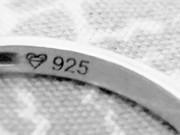Metal allergies are more common than you may think. It can be really disappointing to find a perfect piece of jewelry, only to find out after a few wears later that you are allergic to it. Metal allergies can show up on the skin as redness, swelling, itching, bleeding, and rashes - some may even be painful. If this is something you experience, it is important to know the differences between hypoallergenic jewelry and normal jewelry.

Hypoallergenic jewelry is specifically made for those who experience allergic reactions to certain types of metal. A lot of jewelry companies will state right on the package if the metal used in the jewelry is hypoallergenic. Most people have a reaction to nickel, so it is also important to check if the jewelry is nickel free. Other metals that are hypoallergenic are platinum, rhodium, niobium, and gold.
- Platinum is usually a bit more expensive, but it rarely tarnishes as it is one of the strongest metals in the world.
- Rhodium is in the same metal family as platinum. It can also be a bit more expensive than other metals, but it does not easily tarnish. Many jewelers use rhodium to finish their sterling silver pieces. The rhodium coating can help with anti-tarnish qualities and gives it an extra shine. For example, we use a thick coat of rhodium on our birthstone rings and necklaces.
- Niobium is highly resistant to corrosion and is often used in medical implants and tools. Niobium contains no lead, nickel or other additives - which is why it is hypoallergenic.
- Gold is also a good hypoallergenic option. However, small amounts of other metals can be found within it unless it is 24 kt, which is pure gold. Some people can still wear these pieces without a reaction if the other metal content is low enough.
Is sterling silver hypoallergenic? Well, it depends. Genuine sterling silver gets the label “sterling” because it must be at least 92.5% pure. But the remaining 7.5% can be filled with other types of metal. Most of the time, copper is used, which is great since copper is hypoallergenic. You have to be careful though because other “less reputable” manufacturers will mix in cheaper options, like nickel. The lower the quality, the more likely there will be elements of other metals, such as nickel in the jewelry ; the same thing should be kept in mind for silver plated jewelry and silver filled jewelry. Even though it is cheaper, it does not necessarily mean it is of quality as cheaper metals are usually the base.
The most important thing to do when trying to find hypoallergenic jewelry is to read labels and do your research. It is also important to keep in mind that investing in higher quality hypoallergenic jewelry is a good idea. These pieces will usually last longer and keep your skin from having a bad reaction.






Leave a comment (all fields required)